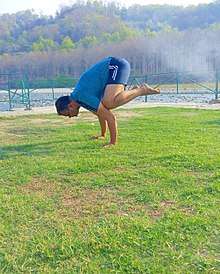Bakasana

Bakāsana (Sanskrit: बकासन, Crane Pose), often used interchangeably with Kakasana (Sanskrit: काकासन, Crow Pose) is an asana.[1] In all variations, Crane/Crow is an arm balancing asana in which hands are planted on the floor, shins rest upon upper arms, and feet lift up.[2]
Etymology
The two names for the asana come from the Sanskrit words baka ("crane") or kak ("crow"), and asana (आसन) meaning "posture" or "seat".[3][4]
While different yoga lineages use one name or another for the asana, Dharma Mittra makes a distinction, citing Kakasana as being with arms bent (like the shorter legs of a crow) and Bakasana with arms straight (like the longer legs of a crane).[5] In the west, practitioners often mistranslate the Sanskrit "Bakasana" as the English "Crow Pose".[2][6]
Description
This asana is considered an arm balance. According to B.K.S. Iyengar there are two techniques for entering into this balance. The simple method of achieving it is by pushing up from a crouching position. The advanced method is to drop down from a head stand.[7]
Benefits
The asana strengthens the shoulders, arms, wrists and hands, as well as the core muscles and organs of the abdomen.[7]
Variations

Asymmetric Variations include:
- Parsva Bakasana (Side Crane Pose) in which one thigh rests on the opposite upper arm and the other leg is stacked on top of the first[8][9]
- Eka Pada Bakasana/Kakasana (One-Legged Crane/Crow Pose respectively) in which one leg remains in Bakasana while the other extends straight back.[10]
- Eka Pada Koundiyanasana I (Pose Dedicated to the Sage Koundinya I) in which one leg remains in Bakasana while the other extends diagonally back and to the side.
- Eka Pada Koundiyanasana II (Pose Dedicated to the Sage Koundinya I) / Ardha Titibasana (Half Firefly Pose), in which one leg is positioned as in Bakasana and the other extends diagonally forward as in Titibasana
Follow-up asanas
Crane/Crow is often followed by Chaturanga Dandasana (Four-Limbed Staff Pose) or Salamba Sirsasana II (Supported Head Stand, Second version). Some practitioners jump in and out of Crane/Crow via Adho Mukha Svanasana (Downward-Facing Dog Pose). Related hand balances include Astavakrasana (Eight-Crooks Pose) and Titibasana (Firefly Pose).
Gallery
See also
References
- ↑ "Yoga Journal - Crane Pose". Retrieved 2011-04-09.
- 1 2 Belling, Noa (20 February 2008). The Yoga Handbook. New Holland Publishers. p. 159. ISBN 978-1-84537-935-3. Retrieved 25 June 2011.
- ↑ Sinha, S.C. (1 June 1996). Dictionary of Philosophy. Anmol Publications PVT. LTD. p. 18. ISBN 978-81-7041-293-9. Retrieved 9 April 2011.
- ↑ Kingsland, Kevin; Kingsland, Venika (1976). Complete hatha yoga. Arco Pub. Co. p. 121. ISBN 978-0-668-03958-1. Retrieved 9 April 2011.
- ↑ Mittra, Dharma (21 March 2003). Asanas: 608 Yoga Postures. New World Library. ISBN 978-1-57731-402-8. Retrieved 25 June 2011.
- ↑ Long, Ray (August 2009). The Key Muscles of Yoga: The Scientific Keys, Volume 1. Greenleaf Book (Distributor). p. 230. ISBN 978-1-60743-238-8. Retrieved 9 April 2011.
- 1 2 Iyengar, B.K.S. (1987) [1966]. Light On Yoga. New York: Schocken Books. pp. 315–317. ISBN 0-8052-0610-8.
- ↑ "Yoga Journal - Side Crane Pose". Retrieved 2011-04-09.
- ↑ Stearn, Jess (1965). Yoga, youth, and reincarnation. Doubleday. p. 348. Retrieved 9 April 2011.
- ↑ Hewitt, James (3 January 1990). Complete Yoga Book. Schocken Books. p. 357. Retrieved 9 April 2011.
Further reading
- Iyengar, B. K. S. (1 October 2005). Illustrated Light On Yoga. HarperCollins. ISBN 978-81-7223-606-9. Retrieved 9 April 2011.
- Saraswati, Swami Satyananda (1 August 2003). Asana Pranayama Mudra Bandha. Nesma Books India. ISBN 978-81-86336-14-4. Retrieved 9 April 2011.
- Saraswati, Swami Satyananda (January 2004). A Systematic Course in the Ancient Tantric Techniques of Yoga and Kriya. Nesma Books India. ISBN 978-81-85787-08-4. Retrieved 9 April 2011.

